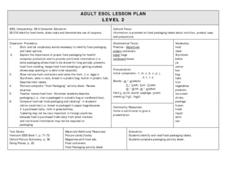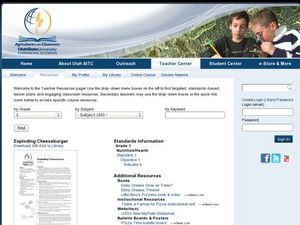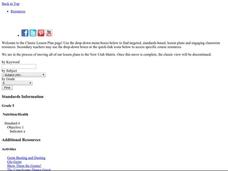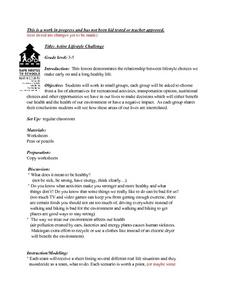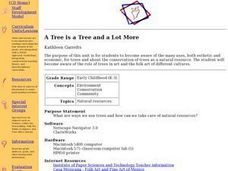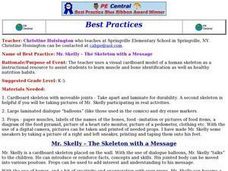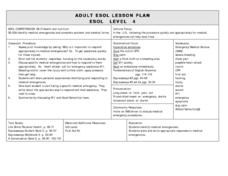Curated OER
ADULT ESOL LESSON PLAN--Level 2--Consumer Education
Pupils, after reviewing an extensive list of vocabulary terms on the board, identify/label food items, how much they cost and the value of using coupons to save money. In addition, they practice reading the labels on the food packaging...
Curated OER
Reading Nutrition Labels
In this nutrition worksheet, students name 2 food labels, then circle which label best fits a series of 12 statements such as "most sodium per serving," etc. Students then write about which item they think is more healthy and why.
Curated OER
Jr. Chef Club Delightful Desserts
Students identify the fat content in foods. For this nutrition lesson, students review the food pyramid and identify foods that are low in fat. Students create a low-fat dessert by using fruit.
Curated OER
Fatty Acids
Students draw connections between chemical structures of fats and oils (lipids) and their use in food science and nutrition.
Curated OER
Vital Signs
Students research health-related topics such as good nutrition, exercise, and the human body. They analyze their data and distribute it through the use of the Internet.
Curated OER
Nutrients In Our Foods
Students use the Internet to learn of, and research, information on health and nutrition. They study the six essential nutrients and explore the Food Pyramid.
Curated OER
Obesity, Eating Habits and Weight Loss
Students conduct Internet research, view film and participate in class discussion to identify the problem and causes of obesity in America. They evaluate the food pyramid and break down the nutritional components of fast food and frozen...
Curated OER
Class and Health: You Are What You Eat
Students determine a working definition of class in order to determine how social class can affect personal health. They research their own nutritional needs and work to encourage healthy change in their communities.
Curated OER
Exploding Cheeseburgers
Young scholars identify the components of a healthy diet. In this nutrition lesson, students discuss the parts of a cheeseburger and identify the food groups the cheeseburger is a part of. Young scholars discuss how carbohydrates and...
Curated OER
Exploding Cheeseburger
Second graders describe the components of a healthy diet. In this nutrition and health lesson, 2nd graders identify the importance in eating a variety of healthy food. Students explain what makes a healthy diet.
Curated OER
Vary Your Veggies and Focus on Fruits
Third graders study a healthy diet. For this healthy diet lesson, 3rd graders investigate the nutritional value of fruits and vegetables. Students compare a healthy diet to their personal diet.
Curated OER
Calorie Countdown
Fifth graders analyze their caloric intake and energy output. In this nutrition and health lesson, 5th graders use the Dietary Guidelines for Americans to evaluate their personal food intake and activity level. Students explore the...
Curated OER
Hand Washing: I Can Handle It!
Fifth graders examine virus transmission. For this health and nutrition lesson, 5th graders explore hand washing and food handling techniques that prevent food borne illnesses. Students name viruses and the diseases caused by them
Curated OER
Label Language
Students practice reading food labels. In this nutrition lesson, students bring in examples of food labels and practice identifying the nutrients in each of the foods. Students determine what changes should be done to the food label to...
Curated OER
Food Systems Feed the World
Fifth graders explore nutrition by viewing video clips discussing world hunger. In this malnutrition lesson plan, 5th graders discuss the reasons people cannot afford food in rural areas and read assigned text discussing our agriculture...
Curated OER
Munching on Mixtures
Students predict, observe, and record what grasshoppers eat to demonstrate an understanding that grasshoppers and people have nutritional requirements to grow and maintain good health.
Curated OER
Active Lifestyle Challenge
Young scholars, in groups, choose from a list of alternatives for recreational activities, transportation options, nutritional choices and other opportunities people have in their lives to make decisions which either benefits or has a...
Curated OER
Watch Your Mouth
Students explore the effects of tooth loss to their bodies. In this oral health lesson students complete several activities that help them determine how tooth loss effects nutrition, facial structure and jaw bones.
Curated OER
A Tree is a Tree and a Lot More
Students listen as the teacher reads "The Giving Tree." they discuss all the things the tree gave the boy throughout his life. They discuss ways they benefit from trees. This studying culminates with a tree walk and planting a tree in a...
Curated OER
Health: The Skeleton with a Message
Pupils identify human muscles and bones from a cardboard skeleton, named "Mr. Skelly." Using dialog balloons as props, the teacher holds up advice from Mr. Skelly, such as noting he drinks milk to keep his bones strong. The lesson also...
Curated OER
Science: Conditions for Slime Mold Survival
Students perform experiments to determine the nutritional needs and physical space requirements for slime mold to survive. After formulating hypotheses, they seal the petri dishes and set up the experiment along with two controls. ...
Curated OER
What's Your Emergency?
Students identify different medical emergencies they may encounter. As a class, they discuss ways in which they can deal with different medical emergencies. Students practice responding to medical emergencies by writing a brief...
Curated OER
Book Box
Students create a bookmark, book cover and book review for a book they read. In this nutrition meets literacy lesson, students read a book about food and complete creative projects based upon the book. Some of the ideas included in this...
Curated OER
Agriculture and Food
Learners discuss the foods they eat and why they eat them. For this nutrition lesson, students determine what foods people might eat in Cyprus and create a traditional meal tasting five traditional recipes of Cyprus set up like stations.


